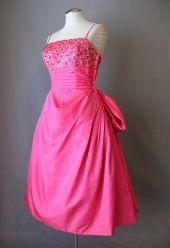In 1933, Harry Houghton of Lightening Fastener's Canadian division offered Elsa Schiaparelli $10,000 (about $175,000 in today's dollar) to use their zippers in her clothing. Schiaparelli decided to use the colorful plastic zippers as a design element in her clothing. She shocked buyers who arrived to view her Winter collection of 1935-36 by using the plastic zippers in unexpected places and in a very visible way. Zippers were found on pockets, necklines, sleeves and shoulder seams.
Actress Frances Drake wore this Schiaparelli wool jersey dress in the 1936 film I'd Give My Life. A Lightening Fastener plastic zipper closes the entire front of the dress.
This Schiaparelli taffeta evening gown from Winter 1935-36 incorporates a decorative YKK plastic zipper placed diagonally on the front of the skirt.
This cotton dress by Schiaparelli is from about 1940 and was shown as part of last summer's High Style exhibit at the Brooklyn Museum. I took this photo of the back of the dress, which has a yellow plastic zipper all the way up the back. You can see here how chunky the zipper looks and the fact that the teeth are left exposed as a design element rather than as a practical way to close the garment.
A close-up of the chunky teeth in the zipper .
Schiaparelli did not use plastic zippers exclusively, nor did she use them when she wanted a hidden or understated closure on a garment. The use of industrial zippers as decoration was an unusual element that became one of her signature looks. The evening gown shown here is from about 1933-34 and uses visible heavy brass zippers at the side seam and the sleeve cuffs.
References:
Dilys E. Blum: Shocking! The Art and Fashion of Elsa Schiaparelli (2003)
Jan Glier Reeder: High Style (2010)




















